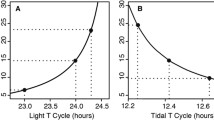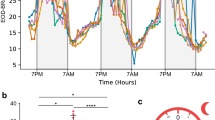Summary
-
1.
The cirral activity of Balanus balanus L. shows a polyphasic pattern, characterized by bursts of activity interspersed with inactive periods. But the condensed activity of Balanus balanus L. does not show any bigeminus. No evidence of a tidal or circadian synchronized rhythm of activity was found in the individuals studied (Figs. 4, 7, 9,10).
-
2.
A free-running endogenous periodicity is imprinted in all individuals. Its pattern is biphasic with 25–35 days between major maxima, and between these major peaks there are three subordinate maxima at intervals of 5–10 days (Figs. 5 to 7). The pattern is highly stable even under extreme conditions (Fig. 8), and persists as long as the barnacles are active. Under L/D-conditions this characteristic pattern continues, but there is more activity during dark periods than during light periods (Fig. 6).
-
3.
Under L/D-conditions up to 80% of the activity take place during the dark periods. This L/D-pattern holds for all L/D-frequencies up to 1/1 hour (Figs. 9, 11). The general arhythmic activity together with this variable L/D-pattern excludes regulation by an innate biological clock. Masking effects, which could hide a circadian periodicity, can be excluded (see discussion). As a sessile organism Balanus balanus L. is an example of regulated exogenous diurnal activity. Endogenous and exogenous patterns are demonstrated.
-
4.
The pecularities in the activity of the barnacles, spontaneous or under L/D-conditions, are discussed in relation to their habits.
Zusammenfassung
-
1.
Die Aktivität von Balanus balanus L. ist polyphasisch, d. h., sie ist in viele kurze Schübe aufgeteilt. Ihre Zusammenfassung ergibt jedoch keinen Bigeminus. Tages- oder Gezeitenperiodik konnte nicht nachgewiesen werden (Abb. 4, 7, 9, 10).
-
2.
Eine freilaufende, wahrscheinlich rein endogene, Langzeitperiodik ist den Individuen fest eingeprägt. Sie weist zwei Hauptmaxima im Abstand von 25–35 Tagen und drei dazwischenliegende Nebenmaxima im Abstand von 5–10 Tagen auf (Abb. 5–7). Sie ist auch unter extremen Bedingungen immer nachzuweisen (Abb. 8) und überlagert alle Aktivitätsäußerungen der Seepocken. Im L/D-Wechsel ist ihr Muster in der Aktivitätsmenge während der Dunkelzeiten deutlicher zu erkennen als in der Aktivitätsmenge während der Hellzeiten (Abb. 6).
-
3.
Im L/D-Wechsel ist Balanus balanus L. dunkelaktiv und verlegt bis zu 80% seiner Aktivität in die Dunkelzeiten. Mit dieser Dunkelaktivität folgt er den vorgegebenen Frequenzen bis hinauf zum 1/1stündigen L/D-Wechsel verzögerungsfrei (Abb. 9, 11). Zusammen mit der arhythmischen Aktivität macht diese rasche Umstimmbarkeit die Steuerung der Aktivität durch eine innere Uhr unwahrscheinlich. Maskierungseffekte, die eine zirkadiane Periodik verdecken können, liegen offenbar nicht vor (s. Diskussion). Balanus balanus L. bietet als sessiler Organismus das Beispiel für eine rein exogen gesteuerte Aktivität. Endogene und exogene Anteile in den Aktivitätsäußerungen lassen sich voneinander trennen.
-
4.
Die Eigentümlichkeiten der spontanen und reizbedingten Aktivitätsäußerungen der Seepocken werden im Zusammenhang mit ihrer Lebensweise diskutiert.
Similar content being viewed by others
Literatur
Aschoff, J.: Die Tagesperiodik licht- und dunkelaktiver Tiere. Rev. suisse Zool. 71, 528–508 (1964).
—, Wever, R.: Resynchronisation der Tagesperiodik von Vögeln nach Phasensprung des Zeitgebers. Z. vergl. Physiol. 46, 321–325 (1963).
Banse, K.: On the vertical distribution of zooplankton in the sea. Prog. Oceanogr. 2, 53–125 (1964).
Barnes, H., Barnes, M.: Note on the opening response of Balanus balanoides L. in relation to salinity and certain inorganic ions. Veröff. Inst. Meeresforsch. Bremerhaven 5, 160–164 (1958).
—, Finlayson, D. M., Piatigorsky, J.: The effect of desiccation and anaerobic conditions on the behaviour, survival and general metabolism of three common cirripedes. J. Anim. Ecol. 32, 233–254 (1963).
Blume, J., Bünning, E., Günzler, E.: Zur Aktivitätsperiodik bei Höhlentieren. Naturwissenschaften 49, 525 (1962).
Buddenbrock, W. v.: Untersuchungen über den Schattenreflex. Z. vergl. Physiol. 13, 164–213 (1931).
Busnel, R. G., Dziedzic, A.: Rythme du bruit de fond de la mer á proximité des côtes et relations avec l'activité acoustique des populations d'un cirripéde fixé immergé. Cah. océanogr., Ann. 14, No 5, 293–322 (1962).
Cloudsley-Thompson, J. L.: Rhythmic Activity in Animal Physiology and Behaviour, 236 pp. New York u. London: Academic Press 1961.
Cole, W. H.: The relation between temperature and the pedal rhythm of Balanns. J. gen. Physiol. 12, 599–608 (1929).
—: The sensitivity of the cirri and the variability of their movements in the barnacles Balanus tintinnabulum and B. balanoides. J. exp. Zool. 63, 143–153 (1932).
Crisp, D. J.: An assessment of plankton grazing by barnacles. Symp. Brit. Ecol. Soc. No 4, 251–165 (1964).
—, Southward, A. J.: Different types of cirral activity of barnacles. Phil. Trans. B 243, 271–308 (1961).
Daniel, A.: The respiratory mechanism of Balanus tintinnabulum L. J. Madras Univ. B 22, 261–267 (1952).
Fox, H. M., Johnson, M. L.: The control of respiratory movements in crustacea by oxygen and carbon dioxide. J. exp. Biol. 11, 1–10 (1934).
Hedgepeth, J. W. (Ed.): Treatise on marine Ecology and Palaeecology, 1296 pp. Washington D. C. 1957.
Minnich, D. E.: A preliminary study of the light-reaction of the rock barnacle, Balanus balanoides. Bull. Mt. Desert Island, Biol. Lab. 24 (1940).
Monterosso, B.: Studii cirripedologici. III. Persistenza dei fenomeni respiratori nei ctamalini mantenuti in ambiente subaereo. Boll. Soc. Biol. Sper. 3, 1067–1070 (1928).
Mori, S.: Rhythmic activity of the seaside barnacle Tetraclita squamosa japonica Pilsbry. Mem. Coll. Sci. Univ. Kyoto B 25, 23–30 (1958).
—: Rhythmic activity ot the seaside barnacle Tetraclita squamosa japonica Pilsbry in winter. Publ. Seto mar. biol. Lab. 9, 373–378 (1961).
Müller, H. J.: Autökologie terrestrischer Wirbelloser: Der Faktor Licht. Fortschr. Zool. 16, 500–523 (1964).
Remmert, H.: Der Tagesgang im Strandanwurf und seine ökologische Bedeutung (Saarbrücken 1961). Verh. dtsch. Zool. Ges. 1962, 438–445 (1962).
- Der Schlüpfrhythmus der Insekten, 73 pp. Wiesbaden 1962.
Roaf, H. E.: Contribution to the physiology of marine organisms. II. The influence of the carbon dioxide and oxygen tension on rhythmical movements. J. Physiol. (Lond.) 43, 449–454 (1912).
Sato, R.: Cirri movement of a barnacle, Chthamalus challengeri Hoek and its environments in summer. Ecol. Rev. 7, 236–240 (1941).
Sommer, H.-H.: Aktivitätsperiodik bei Seepocken. Naturwissenschaften. 54, 347–348 (1967a).
—: Hell-Dunkel-Aktivität bei Seepocken. Nachr. Akad. Wiss. Gött. H. 10, 118 (1967b).
- Exogene Steuerung der motorischen Aktivität eines niederen Krebses (Balanus balanus L.) durch Aktivierung zweier Adaptationssysteme des Lichtsinns. Verh. dtsch. Zool. Ges., 65. Jahresvers., Helgoland (1971) (im Druck).
Southward, A. J.: On the behaviour of barnacles. I. The relation of cirral and other activities to temperature. J. marine biol. Ass. 34, 403–422 (1955).
—: On the behaviour of barnacles. II. The influence of habitat and tide-level on cirral activity. J. marine biol. Ass. 34, 423–433 (1955).
—: On the behaviour of barnacles. III. Further observations on the influence of temperature and age on cirral activity. J. marine biol. Ass. 36, 323–334 (1957).
—: On the behaviour of barnacles. IV. The influence of temperature on cirral activity and survival of some warm-water species. J. marine biol. Ass. 42, 163–177 (1962).
—, Crisp, D. J.: Activity rhythms of barnacles in relation to respiration and feeding. J. marine biol. Ass. 45, 161–185 (1965).
Stefan, M.: Study of periodic activity of Black Sea Balanus. J. Gen. Biol. (Moskow) 22, 78–80 (1960) [in Russisch].
Waldes, V.: Über die chemische Beeinflussung des Rhythmus und der Retraktionsdauer der Cirren von Balanus perforatus. Z. vergl. Physiol. 26, 347–361 (1939).
Wever, R.: Einzelorganismen und Populationen im circadianen Experiment. Eine methodische Analyse. Z. vergl. Physiol. 51, 1–24 (1965).
Author information
Authors and Affiliations
Additional information
Die vorliegende Arbeit wurde am I. Zoologischen Institut der Universität Göttingen begonnen.
Rights and permissions
About this article
Cite this article
Sommer, H.H. Endogene und exogene Periodik in der Aktivität eines niederen Krebses (Balanus balanus L.). Z. Vergl. Physiol. 76, 177–192 (1972). https://doi.org/10.1007/BF00455961
Received:
Issue Date:
DOI: https://doi.org/10.1007/BF00455961




